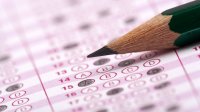How to Reduce Guessing During Testing Season
Metacognitive tasks can help eliminate guessing and ensure that elementary students show what they know on standardized tests.
In my class, there’s a terrible word we never use that starts with the letter G. That word is guessing. We’ve all been told that if we don’t know an answer to a question, our last resort should be to guess. But there’s so much more we can do before we get there.
As we near the first state-mandated testing window in two years, it’s going to be important that all of us, and our students, know when we’re guessing and why we shouldn’t do it except as a last resort. But there is something even more important that kids can be taught explicitly: what guessing is and how we can overcome the urge to do it.
In my class, we prepare for state-mandated testing in ways that go beyond worksheets and spiral review practice. Specifically, we do a few metacognitive tasks that target, redefine, and eliminate guessing as much as possible. These tasks involve habituation, language frames, and expectations that will work in a variety of classrooms. Here’s how I do it.
Explain the Specifics of Guessing to Students
Guessing is one of those strange words that we think kids know. Yet the longer I teach, the more I see that my kids don’t know the term the way I do. How many questions do we ask of students that don’t always have a clearly defined answer? In fact, as pedagogy grows, we often deliberately ask more and more open-ended questions, and for good reason. We want kids to feel comfortable throwing out possible solutions or ideas, even when they’re wrong. But sadly, in state examinations, kids don’t have an opportunity to explain, debate, or discuss open-ended questions.
To overcome that challenge, in my classroom, my students and I brainstorm together when and how we guess. I’ll often use a note-catcher, such as a circle map, and add ideas using one color of marker. Typical input from kids includes things like “I’m guessing when I just choose any answer” and “I guess by eliminating one or two choices, but then I just guess at one of the last two.” After these revelations, I guide students toward an understanding of what guessing means in a testing context: choosing an answer without enough evidence to support the choice.
In various classes, this can take different levels of scaffolding, and it might require multiple conversations. Once a more detailed concept of guessing is established, kids have a basis to help them do better for all types of test opportunities, not just for some.
For the next part, you’ll need two colors of marker, a chart of language frames, and a good old-fashioned teacher story.
A Student-Centered Context to Understand Guessing
My favorite anti-guessing story is about the Beagle 2 lander, which failed as it descended to the surface of Mars in 2012. Although Hollywood told us it might have been robot aliens, the consensus from most engineers is that its parachutes were not deployed properly because, wait for it, they were not tested properly.
“Imagine,” I tell students, “that your job is to build the parachutes that will deploy during the Beagle’s landing. Hundreds of people worked on the project, which cost $20 million. What would you do differently?”
I now switch to the second marker and record in a new color while students share out their responses. Typical responses now include, “I’d do all the math calculations twice” or “I’d make a model of the parachute and run different simulations.” Inevitably, there’ll be a clear contrast between the two-toned responses on the chart. And that’s exactly what you’re looking for. At this stage, we make a plan together, where I set expectations for how students are expected to avoid guessing. I ask the class to discuss ideas about how we can avoid guessing in our classroom.
On a second chart, I record these ideas in a list, which will soon become our testing norms. Typical responses for math usually include “If we’re solving math problems that we can’t do in our head, we should do the work neatly on paper” or “We can estimate even if we can’t solve the problem.” For literacy, a typical norm sounds like: “If I was to be asked by a partner during the test why I chose that answer, I’d be able to explain it to them.” Be sure to consider ahead of time what norms you’re looking for, so as to nudge your students toward that understanding with you. I find that talking to students one-on-one or in small groups about previously missed questions can be very helpful.
Use Language Frames to Find Appropriate Answers
For the next step, we create language frames, generated from our anti-guessing norms. It’s usually best if these are practiced first in easier spiral work, for either math or literacy questions. Typical phrases for math include explaining the steps taken to solve a math question, using transitions. Students then explain why their answer is reasonable, using an estimate. For literacy, students can refer to the text and use evidence there to explain their response. Literacy language frames will often use the words best or better, because there can appear to be more than one choice in English language arts exams.
Once students have practiced their norms and used language frames to practice their explanation to partners, have them take an examination they did earlier in the year, with these new measures in place. In my class, the discussion afterward is motivating and uplifting. My students always enjoy being able to see that they now have the necessary strategies to do much better on tests than they did without them. This both alleviates anxiety and gives them a sense of empowerment in a rather powerless situation.
